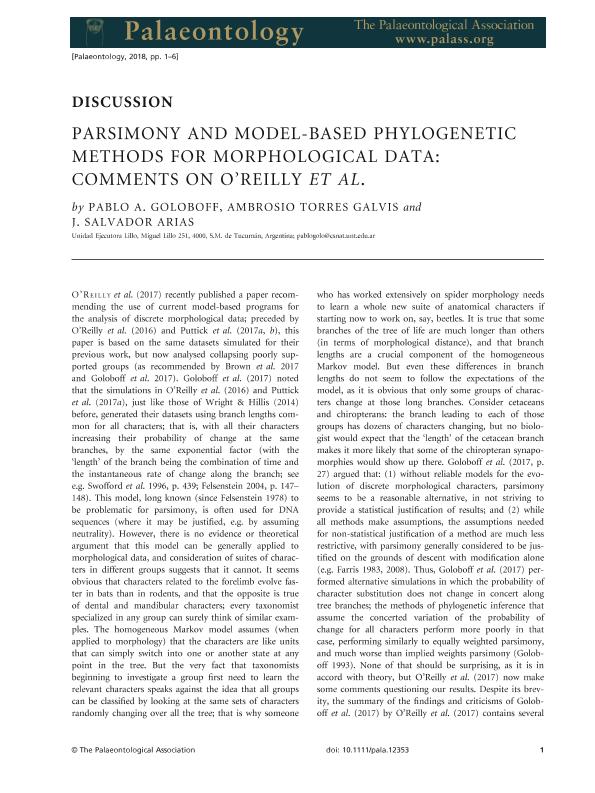Mostrar el registro sencillo del ítem
dc.contributor.author
Goloboff, Pablo Augusto

dc.contributor.author
Torres Galvis, Ambrosio

dc.contributor.author
Arias Becerra, Joan Salvador

dc.date.available
2019-10-17T20:01:36Z
dc.date.issued
2018-04
dc.identifier.citation
Goloboff, Pablo Augusto; Torres Galvis, Ambrosio; Arias Becerra, Joan Salvador; Parsimony and model-based phylogenetic methods for morphological data: comments on O'Reilly et al .; Wiley Blackwell Publishing, Inc; Palaeontology; 61; 4; 4-2018; 625-630
dc.identifier.issn
0031-0239
dc.identifier.uri
http://hdl.handle.net/11336/86184
dc.description.abstract
O´Reilly et al. (2017) have recently published a paper recommending the use of current model-basedprograms for the analysis of discrete morphological data; preceded by O´Reilly et al. (2016) and Puttick et al.(2017a, b), this paper is based on the same datasets simulated for their previous paper, but now analyzedcollapsing poorly supported groups (as recommended by Brown et al. 2017 and Goloboff et al. 2017).Goloboff et al. (2017) noted that the simulations in O´Reilly et al. (2016) and Puttick et al. (2017a), just likethose of Wright and Hillis (2014) before, generated their datasets using branch lengths common for allcharacters ? that is, with all their characters increasing their probability of change at the same branches, by thesame exponential factor (with the ?length? of the branch being the combination of time and the instantaneousrate of change along the branch; see e.g. Swofford et al. 1996, p. 439, Felsenstein 2004, p. 147?148). Thismodel, long known (since Felsenstein 1978) to be problematic for parsimony, is often used for DNAsequences (where it may be justified, e.g. by assuming neutrality). However, there is no evidence ortheoretical argument that this model can be generally applied to morphological data, and consideration ofsuites of characters in different groups suggests it cannot. It seems obvious that characters related to forelimbevolve faster in bats than in rodents, and that the opposite is true of dental and mandibular characters; everytaxonomist specialized in any group can surely think of similar examples. The homogeneous Markov modelassumes (when applied to morphology) that the characters are like units that can simply switch into one oranother state at any point in the tree. But the very fact that taxonomists first learning a group need to learn therelevant characters speaks against the idea that all groups can be classified by looking at the same sets ofcharacters randomly changing over all the tree ? that is why someone who has worked extensively on spidermorphology needs to learn a whole new suite of anatomical characters if starting now to work on, say, beetles.It is true that some branches of the tree of life are much longer than others (in terms of morphologicaldistance), and that branch lengths are a crucial component of the homogeneous Markov model.
dc.format
application/pdf
dc.language.iso
eng
dc.publisher
Wiley Blackwell Publishing, Inc

dc.rights
info:eu-repo/semantics/openAccess
dc.rights.uri
https://creativecommons.org/licenses/by-nc-sa/2.5/ar/
dc.subject
PHYLOGENETICS
dc.subject
PARSIMONY
dc.subject
SIMULATIONS
dc.subject.classification
Biología

dc.subject.classification
Ciencias Biológicas

dc.subject.classification
CIENCIAS NATURALES Y EXACTAS

dc.title
Parsimony and model-based phylogenetic methods for morphological data: comments on O'Reilly et al .
dc.type
info:eu-repo/semantics/article
dc.type
info:ar-repo/semantics/artículo
dc.type
info:eu-repo/semantics/publishedVersion
dc.date.updated
2019-10-16T19:13:41Z
dc.journal.volume
61
dc.journal.number
4
dc.journal.pagination
625-630
dc.journal.pais
Reino Unido

dc.journal.ciudad
Londres
dc.description.fil
Fil: Goloboff, Pablo Augusto. Consejo Nacional de Investigaciones Científicas y Técnicas. Centro Científico Tecnológico - Tucumán. Unidad Ejecutora Lillo; Argentina
dc.description.fil
Fil: Torres Galvis, Ambrosio. Consejo Nacional de Investigaciones Científicas y Técnicas. Centro Científico Tecnológico - Tucumán. Unidad Ejecutora Lillo; Argentina
dc.description.fil
Fil: Arias Becerra, Joan Salvador. Consejo Nacional de Investigaciones Científicas y Técnicas. Centro Científico Tecnológico - Tucumán. Unidad Ejecutora Lillo; Argentina
dc.journal.title
Palaeontology

dc.relation.alternativeid
info:eu-repo/semantics/altIdentifier/url/http://doi.wiley.com/10.1111/pala.12353
dc.relation.alternativeid
info:eu-repo/semantics/altIdentifier/doi/https://dx.doi.org/10.1111/pala.12353
Archivos asociados
